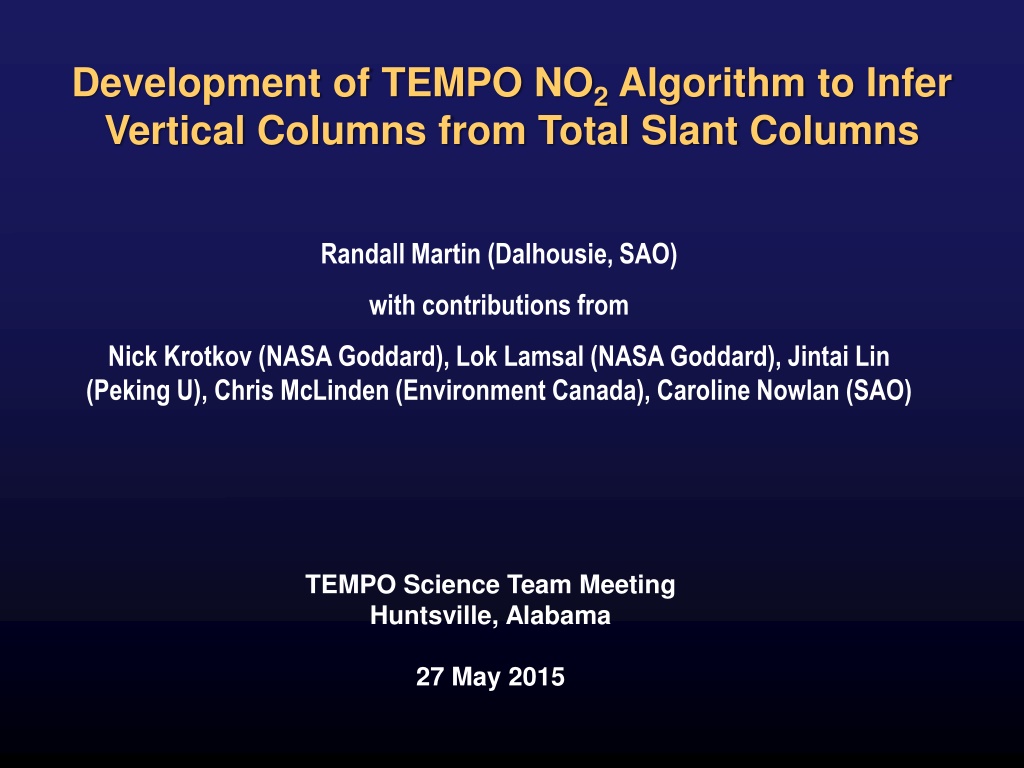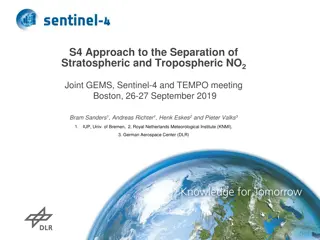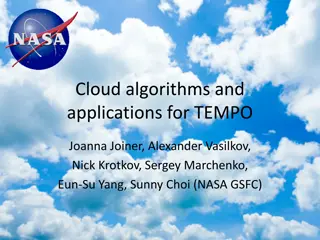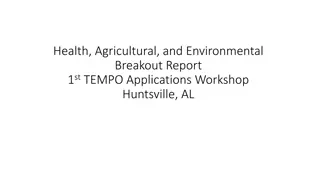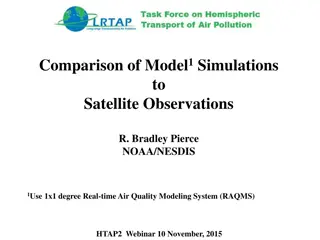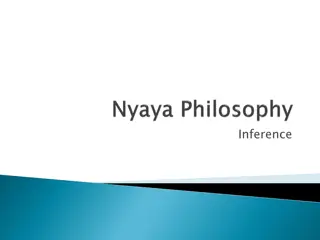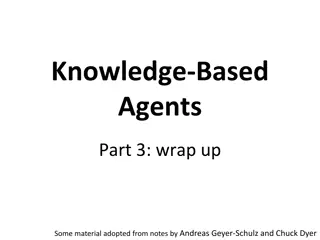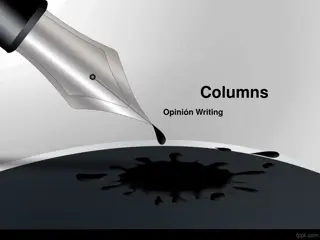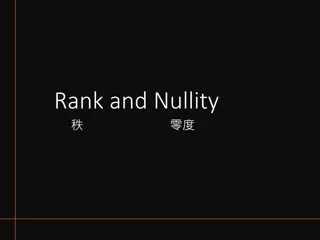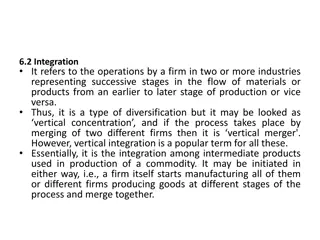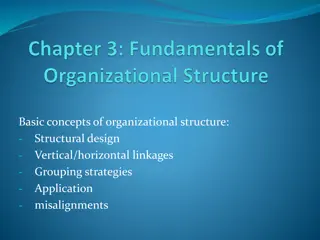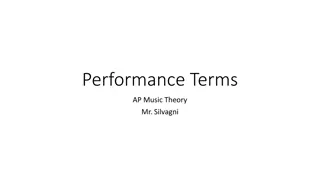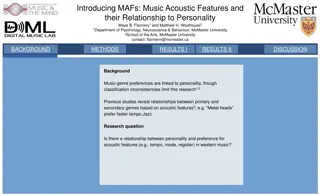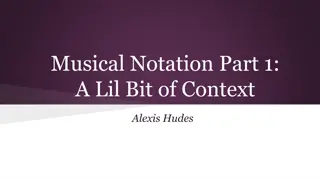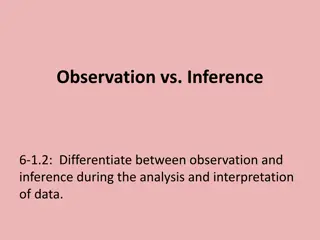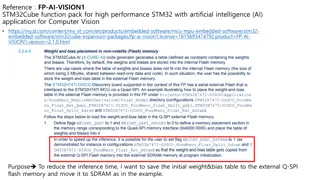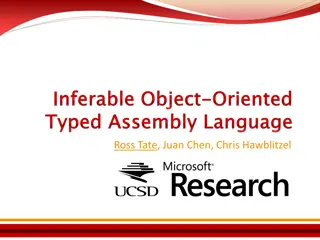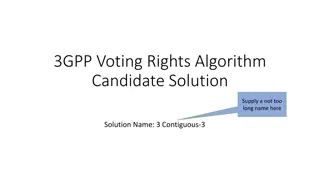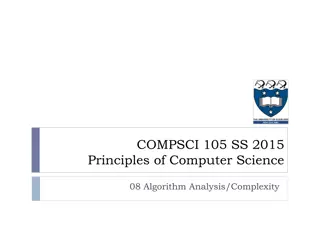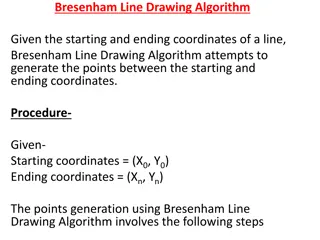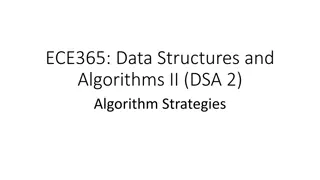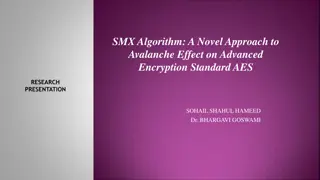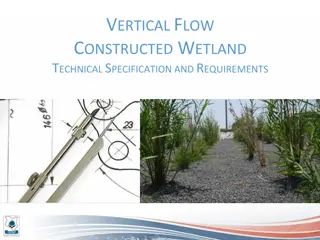Developments in Vertical Columns Inference for TEMPO NO2 Algorithm
The development of the TEMPO NO2 algorithm to infer vertical columns from total slant columns involves contributions from various experts, such as Randall Martin, Nick Krotkov, Lok Lamsal, Jintai Lin, Chris McLinden, and Caroline Nowlan. Attention is needed for the removal of stratospheric NO2 and adaptation to OMI algorithms for TEMPO, considering diurnal variations and boundaries. Challenges in AMF calculation for TEMPO include representing diurnal variations in surface reflectance, resolving altitude geophysical fields, and accounting for aerosols. The current operational LEO AMF algorithms treat aerosols as clouds, impacting the sensitivity to trace gases and the effects of aerosol haze on cloud and NO2.
Download Presentation

Please find below an Image/Link to download the presentation.
The content on the website is provided AS IS for your information and personal use only. It may not be sold, licensed, or shared on other websites without obtaining consent from the author. Download presentation by click this link. If you encounter any issues during the download, it is possible that the publisher has removed the file from their server.
E N D
Presentation Transcript
Development of TEMPO NO2 Algorithm to Infer Vertical Columns from Total Slant Columns Randall Martin (Dalhousie, SAO) with contributions from Nick Krotkov (NASA Goddard), Lok Lamsal (NASA Goddard), Jintai Lin (Peking U), Chris McLinden (Environment Canada), Caroline Nowlan (SAO) TEMPO Science Team Meeting Huntsville, Alabama 27 May 2015
Attention Needed to Removal of Stratospheric NO2 Adaptation to OMI algorithms to TEMPO will require consideration of diurnal variation and boundaries (more from Lok Lamsal) Stratospheric Assimilation May Offer Advantages Fraction of total NO2 column in the troposphere can be small Urban/Industrial areas: 30-80% Rural/background areas: 10-30% 70 Annual mean, from OMI (2009) 0.5 Tropospheric Fraction 60 0.4 50 Fraction 0.3 40 0.2 30 0.1 20 0 -150 -100 -50 Figure from Chris McLinden
Need to Account for Atmospheric Scattering and Vertical Profile (Air Mass Factor; AMF) in UV-Vis Retrievals Often Largest Source of Uncertainty in LEO Retrievals Radiative Transfer Model Atmospheric Chemistry Model IB a-priori Shape factor Io sigma ( ) ( ) = ( ) air S C d ( ) EARTH SURFACE Mixing ratio C( ) ( ln I ) 1 B ( = ) w Scattering weight AMF G e ( ) is temperature dependent cross-section INDIVIDUAL TEMPO SCENES Calculate w( ) as function of: solar and viewing zenith angle surface reflectance, pressure cloud pressure, aerosol 1 slant T = = ( ( AMF AMF ) ) w S d G vertical
Challenges in Development of AMF Calculation for TEMPO Representing diurnal variation in surface reflectance at launch (use GOES-R spatially & TROPOMI spectrally) Diurnal variation in trace gas profile (changes rapidly in morning; need to evaluate; more from Lok Lamsal) Altitude Resolve geophysical fields at fine resolution (e.g. BEHR) Concentration Accounting for aerosols (still unresolved for LEO). Existing cloud products partially account for aerosol Surface reflectance (BRDF & snow)
Current Operational LEO AMF Algorithms Treat Aerosol as Cloud: Prone to Bias when Together Including Aerosols in Retrievals of Both Clouds and Trace Gases Can Consistently Account for Their Effects Clouds Decrease Sensitivity to Trace Gas Below Average Tends to Decrease Sensitivity to Trace Gas Below Aerosols Increase Sensitivity to Trace Gas Within Haze Layer Accounting for Effects of Aerosol Haze on Cloud and NO2 Increases R2 (0.72 NO2 vs Ground-based DOAS Observations in China (Lin et al., ACP, 2014) 0.96) of OMI
Should Account for Bidirectional Reflectance Distribution Function (BRDF) Sun Behind Observer Sun Opposite Observer AMF Sensitive to Surface Figure from Lok Lamsal Can introduce changes in retrieved NO2 of +/- 50% (Lin et al., ACPD, 2015) Information available from MODIS and forthcoming from GEOS-R Will also be important over snow
Address Potential Retrieval Bias for Snow-Covered Scenes Create Separate Reflectance Databases for Snow-Free and Snowy Scenes Snow Identification: IMS (NOAA/NESDIS) or CaLDAS (Env. Canada) All Cloud Fractions With Cloud Fraction Threshold (f < 0.3) -0.5 0 1.0 0.5 original corrected corrected Expected Relative OMI NO Bias 2 O Byrne et al., JGR, 2010
Plan for TEMPO Algorithm Implementation Basic algorithm (default standard algorithm) a) empirical stratospheric removal b) AMF without aerosols c) Lambertian reflectance d) Combined snow-free & snow-covered reflectance e) Research algorithm (components become standard when mature) a) stratospheric assimilation b) AMF with aerosols c) BRDF d) Separate snow-free & snow-covered reflectance e)
Snow Cover IMS CMC CaLDAS Best products Provider NOAA/NESDIS Environment Canada / Canadian Meteorological Centre Availability Near-real time Near-real time Spatial Extent Northern Hemisphere North America / Global Spatial resolution (current) 4 x 4 km2 10 x 10 km2 / 24 x 24 km2 Spatial resolution (future) 1 x 1 km2 2.5 x 2.5 km2 / 10 x 10 km2 (~2015/2016) Temporal resolution Current: daily; future: 12-hour Current: 12-hour; future: 6 hour or better Field provided Snow extent (yes / no) Snow depth* Input information satellite imagery; derived mapped products; surface observations CMC: analysis using surface observations CaLDAS: Data assimilation of land- surface model, satellite imagery; surface observations * Could be used to identify fresh snow Figure from Chris McLinden
